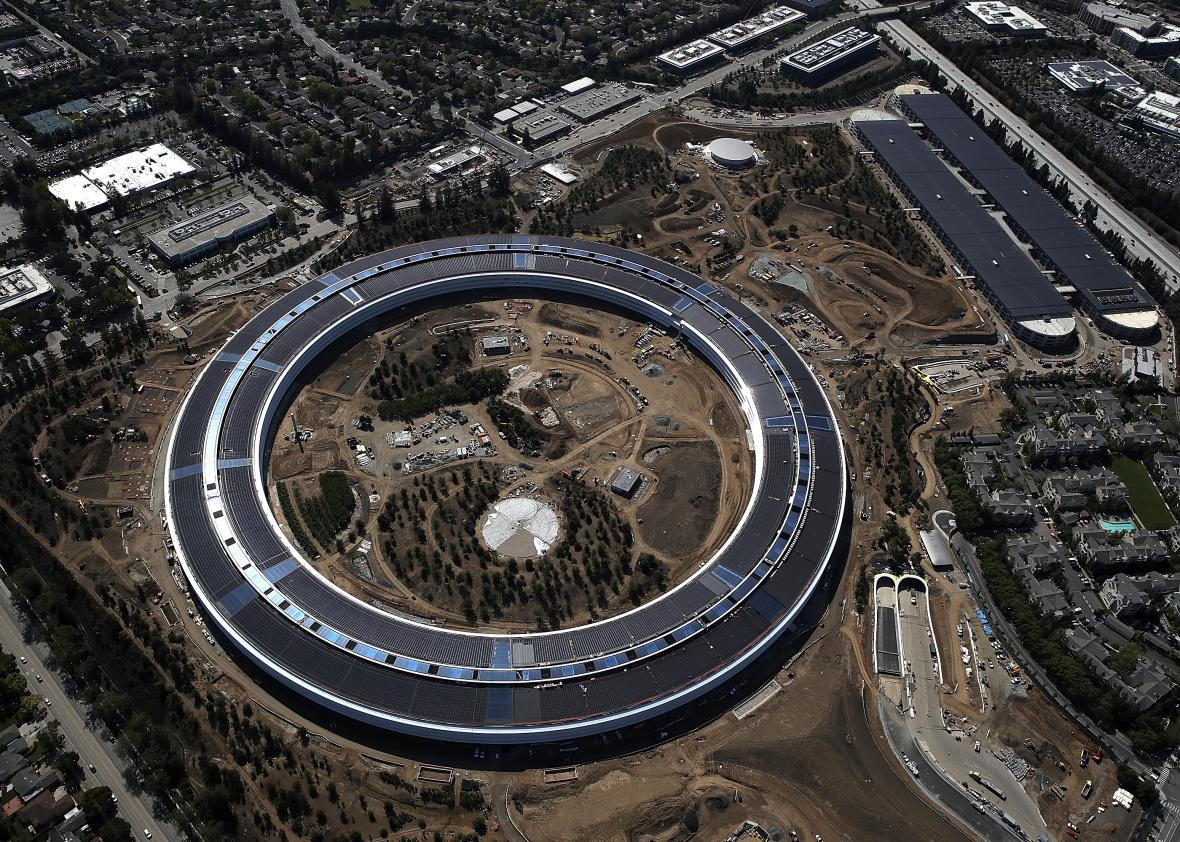From the looks of the spaceship-like monolith that now stands in Cupertino, California, Apple spared no expense in creating its new headquarters. The project required a team of 250 architects, eight years, and $5 billion to build. But even though the campus boasts a luxury wellness center, as many trees as a national park, and custom-designed door handles, it does not offer, as has been pointed out on Twitter, a child care center.
Wired magazine’s June issue contains the first photos from Apple’s new campus, set on 175 soon-to-be–verdant acres in Cupertino. In an accompanying story, journalist Steven Levy describes Apple CEO Steve Jobs’ quest—apparently, his dying wish—to make “the best office building in the world” for Apple’s 12,000 employees. The way Jobs saw it (with typical self-aggrandizement), he wasn’t simply building a new headquarters but “planning the future of Apple itself,” a building that would motivate engineers and designers to work harder, smarter, and better.
Among the amenities the new campus offers are a “100,000-square-foot fitness and wellness center complete with a two-story yoga room covered in stone, from just the right quarry in Kansas, that’s been carefully distressed, like a pair of jeans, to make it look like the stone at Jobs’ favorite hotel in Yosemite,” just to name one luxe example. The center also will provide medical and dental services for employees. Hey, we’re talking about the best office building in the world here, nothing is out of reach! The company certainly has the resources to think through every detail, as evidenced by the way a parking garage made Apple design chief Jonathan Ive “quiver with enthusiasm.”
So why the lack of child care? Apple’s not the first tech company to decide against providing day care while opting for seemingly more lavish perks. Shouldn’t Apple and companies like it want to set an example that the workplace of the future cares about its employees’ families? If it cares about surrounding workers with 9,000 “drought-tolerant” trees, planted by Steve Jobs’ handpicked arborist, why not their kids? Most workers don’t routinely cite trees as a benefit they’re looking for in their workplaces, whereas at one company with on-site childcare, 98 percent of employees who used it said the service made them more likely to stay at the firm. It can be an especially important factor for retaining a company’s female workforce.
Levy’s piece voices the lack-of-child-care concern in a section that outlines some criticisms the campus has gotten: “Is Apple Park the arcadia outlined by Jobs in his public farewell, or is it an anal-retentive nightmare of indulgence gone wild?” But most of the criticism is about whether the campus will integrate well into the city or will foster innovation; child care only gets a token mention.
Unfortunately, this is just the latest example of people in power failing to consider the importance of child care, not just for women but for all workers who want to be able to devote their energy to doing good work rather than worrying about if they’ll get in trouble for leaving to take their children to the doctor. This dismissive attitude might best be exemplified by President Trump, who has said of on-site care: “You need one person or two people, and you need some blocks and you need some swings and some toys. You know, surely, it’s not expensive.” It’s actually not easy or inexpensive to set up good child care (though some of the cost can be recouped through “tax credits, increased employee engagement and low staff turnover,” as the Wall Street Journal once reported), but those shouldn’t be deterrents for a company with the resources of Apple. Instead, Apple prioritized building a 1,000-seat theater featuring a “20-foot tall, 165-foot-diameter glass cylinder topped with a metallic carbon-fiber roof.” Perhaps we can baby-proof the glass cylinder and stick Apple employees’ children in there? If they won’t all fit, there will just have to be a waitlist.
At 2.8 million square feet, the main building on the campus, known as “the Ring,” wasn’t originally shaped like a circle; Jobs scrapped an earlier design when his son Reed pointed out to him that it would look like male genitalia from above. Can’t have that: “[Y]ou’re never going to be able to erase that vision from your mind,” Jobs reportedly said. Pains were taken to make sure the company didn’t wind up one big laughingstock of a phallus. It’s a shame no such efforts were made to make it look like—much less make it actually like—Apple supports its workers’ desires to start and provide for their families.
